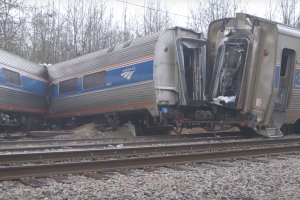National Transportation Safety Board member Bella Dinh-Zarr confirmed at a Monday, December 18 evening press conference that the Amtrak 501 train which derailed earlier in the day in DuPont, Washington was traveling at 80 miles per hour in a 30mph zone. The data was taken from the train’s event data recorder, and suggests the train did not slow down before entering a sharp curve in order to cross a bridge over the I-5 highway.
The train derailed at 7:34 am.
At an evening press conference on Tuesday December 19, Dinh-Zarr confirmed earlier media reports that a second person, a conductor receiving qualifying experience, was in the lead cab of the train. Both event data recorders from the train have been recovered from the two locomotives, and both inward and outward-facing video from the lead cab has been sent back to NTSB headquarters in D.C. in order to retrieve and analyze the data.
The entire train crew was hospitalized, so it may take a few days before the NTSB can interview them to help understand what happened.
According to Dinh-Zarr, the train’s emergency brake auto-engaged during the derailment; it was not manually initiated by the train’s engineer or other member of the crew.
Before crossing the I-5, the track the train was traveling is straight for several miles, paralleling the highway on the north side, with a maximum speed limit of 79mph. The track then drops down to 30mph for trains to safely cross the bridge. In addition to their training, train engineers are notified of the speed limit change by markings on the track wayside two miles before the bridge, and then again half a mile before the bridge, according to Sound Transit who owns this section of track.
The Amtrak Cascades line, which train 501 was operating on, runs from Vancouver, British Columbia to Portland, Oregon and is managed jointly by the Washington State Department of Transportation (WSDOT) and the Oregon Department of Transportation (ODOT). Amtrak is contracted to run trains on the line.
The NTSB says they have not yet definitively determined why the train derailed, or why it was going as fast as it was when it was.
Thirteen of the train’s fourteen cars (including locomotives) derailed, and several fell to the highway below. Three passengers on the train died in the incident, and many more were injured.
A technology that may have automatically slowed the train, Positive Train Control, was not yet in use on this section of track, according to Amtrak president Richard Anderson. The technology was set to be enabled next year.
A statement from Sound Transit who owns the tracks says that “While equipment has been physically installed in the Lakewood subdivision where the incident occurred the system is not yet operational or certified for use. Full implementation is planned to occur by the second quarter of 2018 on that segment, in advance of the [federal PTC installation] deadline.”
The train’s speed data was first reported by asm.transitdocs.com, a real-time train tracker for both Amtrak and VIA trains.







